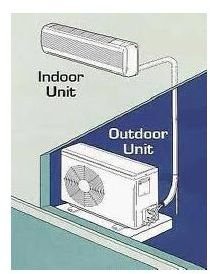Ductless Mini-Split Air Conditioners - Selection, Benefits, Considerations.
Central AC systems have large evaporator coils, condensers, and long runs of ducts. On the other hand, mini-split ductless AC units, as the name suggests, do not have ducts and are small in size. When compared to central AC systems and the larger window units, mini-split ductless AC look like miniature systems.
Image Credit: portable-airconditioner.net
What is a Mini Split Ductless AC?
A mini-split ductless AC system is basically composed of two main units: a condenser and an evaporator. (Many systems also include a remote control.) The condenser is the outside unit. It generates the conditioned air and the evaporator, the inside unit, distributes the air where it is needed. As with any split AC, the air distribution unit can be installed anywhere on the walls. It does not need a window or opening as is the case with window ACs. Both units are connected by refrigerant line-sets and electrical wiring, and there can be a maximum distance of 100 feet between them.
When to prefer a Mini-split Ductless AC
These AC systems are preferred in situations when a home addition is made during a home improvement project or when you have converted a garage into a home office or family room. To cool or heat these new structures, your existing central AC and furnace might not work.
Moreover, adding a mini unit may be more financially feasible. You might also consider a window AC, but in this case too, the mini-split ductless AC would be the preferred choice because it is more convenient and more energy efficient.
Selecting a Mini-Split Ductless AC
Selecting your mini-split ductless AC is all about choosing the right level of cooling power. This cooling power is measured in terms of BTUs or “tons.” 1 Ton AC = 12,000 BTUs. You need to select a cooling unit according to the size of the room. Although most mini splits can cool more than one room (by using more than one evaporator), a single evaporator is most common. It is important to make sure that the evaporator fan size is correct according to the zone.
For an 8’ ceiling size, you can consider the cooling power of the mini-split AC given below.
BTU Rating, Voltage, and Approximate Cooling Area
- 9,000 120/240 200-400 sq. ft.
- 12,000 120/240 400-600 sq. ft.
- 18,000 240 600-900 sq. ft.
- 24,000 240 900-1,200 sq. ft.
Benefits of Mini-split Ductless AC
The most obvious advantage of using mini-split ductless AC is the elimination of duct work. Without ducts, there is no buildup of mold or mildew and no risk of associated allergies. Too, these ACs are great energy savers due to the elimination of ducts. They can save up to 40 % of energy even when compared with most efficient central AC system and up to 60% in case of an older central unit. The small size of the mini-split AC makes them very flexible as they can be mounted in different zones. Installation of a mini-split AC is also simple and fast: it takes around 3 to 5 hours only.
Disadvantages of Mini Split Ductless ACs
The most significant disadvantage is its high initial investment compared to window units. However, they compare favorably to the cost of extending the existing ducting of a house into a new room. Additionally, the high initial costs are covered in time with low running costs and energy efficiency.
A ductless mini-split system is an appropriate choice for cooling and heating your home in different seasons with less energy consumption.
